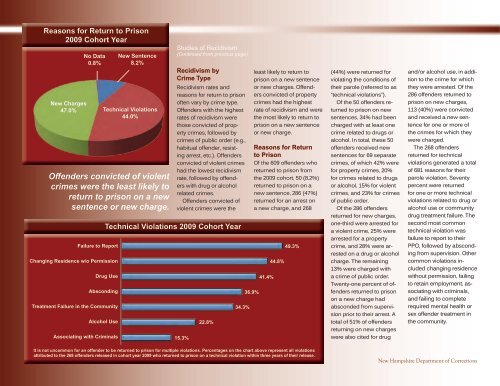annual-report-2014
annual-report-2014
annual-report-2014
Create successful ePaper yourself
Turn your PDF publications into a flip-book with our unique Google optimized e-Paper software.
Reasons for Return to Prison<br />
2009 Cohort Year<br />
No Data<br />
0.8%<br />
New Sentence<br />
8.2%<br />
New Charges<br />
47.0% Technical Violations<br />
44.0%<br />
Offenders convicted of violent<br />
crimes were the least likely to<br />
return to prison on a new<br />
sentence or new charge.<br />
Failure to Report<br />
Changing Residence w/out Permission<br />
Absconding<br />
Treatment Failure in the Community<br />
Alcohol Use<br />
Associating with Criminals<br />
Studies of Recidivism<br />
(Continued from previous page)<br />
Recidivism by<br />
Crime Type<br />
Recidivism rates and<br />
reasons for return to prison<br />
often vary by crime type.<br />
Offenders with the highest<br />
rates of recidivism were<br />
those convicted of property<br />
crimes, followed by<br />
crimes of public order (e.g.,<br />
habitual offender, resisting<br />
arrest, etc.). Offenders<br />
convicted of violent crimes<br />
had the lowest recidivism<br />
rate, followed by offenders<br />
with drug or alcohol<br />
related crimes.<br />
Offenders convicted of<br />
violent crimes were the<br />
Technical Violations 2009 Cohort Year<br />
Drug Use<br />
15.3%<br />
22.8%<br />
34.3%<br />
least likely to return to<br />
prison on a new sentence<br />
or new charges. Offenders<br />
convicted of property<br />
crimes had the highest<br />
rate of recidivism and were<br />
the most likely to return to<br />
prison on a new sentence<br />
or new charge.<br />
Reasons for Return<br />
to Prison<br />
Of the 609 offenders who<br />
returned to prison from<br />
the 2009 cohort, 50 (8.2%)<br />
returned to prison on a<br />
new sentence, 286 (47%)<br />
returned for an arrest on<br />
a new charge, and 268<br />
36.9%<br />
41.4%<br />
44.8%<br />
49.3%<br />
(44%) were returned for<br />
violating the conditions of<br />
their parole (referred to as<br />
“technical violations”).<br />
Of the 50 offenders returned<br />
to prison on new<br />
sentences, 34% had been<br />
charged with at least one<br />
crime related to drugs or<br />
alcohol. In total, these 50<br />
offenders received new<br />
sentences for 69 separate<br />
crimes, of which 42% were<br />
for property crimes, 20%<br />
for crimes related to drugs<br />
or alcohol, 15% for violent<br />
crimes, and 23% for crimes<br />
of public order.<br />
Of the 286 offenders<br />
returned for new charges,<br />
one-third were arrested for<br />
a violent crime, 25% were<br />
arrested for a property<br />
crime, and 28% were arrested<br />
on a drug or alcohol<br />
charge. The remaining<br />
13% were charged with<br />
a crime of public order.<br />
Twenty-one percent of offenders<br />
returned to prison<br />
on a new charge had<br />
absconded from supervision<br />
prior to their arrest. A<br />
total of 51% of offenders<br />
returning on new charges<br />
were also cited for drug<br />
and/or alcohol use, in addition<br />
to the crime for which<br />
they were arrested. Of the<br />
286 offenders returned to<br />
prison on new charges,<br />
113 (40%) were convicted<br />
and received a new sentence<br />
for one or more of<br />
the crimes for which they<br />
were charged.<br />
The 268 offenders<br />
returned for technical<br />
violations generated a total<br />
of 681 reasons for their<br />
parole violation. Seventy<br />
percent were returned<br />
for one or more technical<br />
violations related to drug or<br />
alcohol use or community<br />
drug treatment failure. The<br />
second most common<br />
technical violation was<br />
failure to <strong>report</strong> to their<br />
PPO, followed by absconding<br />
from supervision. Other<br />
common violations included<br />
changing residence<br />
without permission, failing<br />
to retain employment, associating<br />
with criminals,<br />
and failing to complete<br />
required mental health or<br />
sex offender treatment in<br />
the community.<br />
18<br />
It is not uncommon for an offender to be returned to prison for multiple violations. Percentages on the chart above represent all violations<br />
attributed to the 268 offenders released in cohort year 2009 who returned to prison on a technical violation within three years of their release.<br />
New Hampshire Department of Corrections


